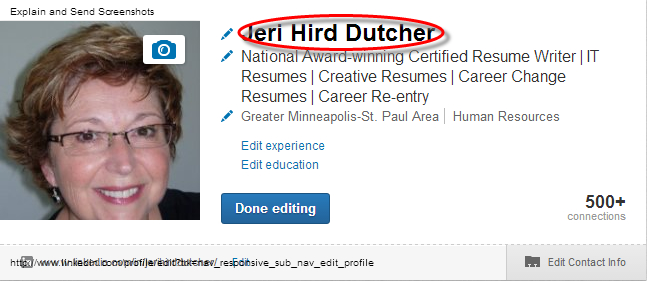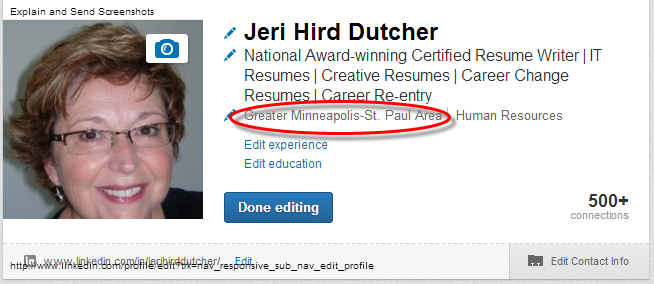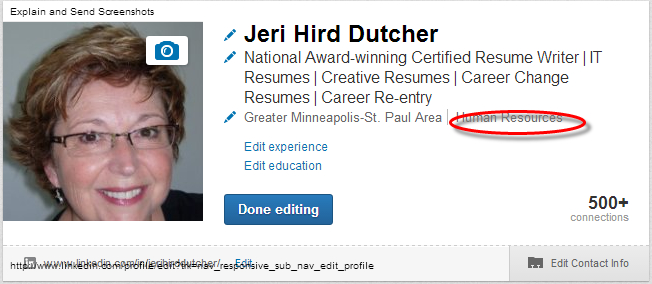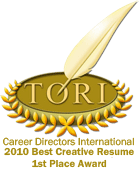
LinkedIn becomes more important every day to job seekers and job keepers. As many as 75% of employers now search for new employees through LinkedIn. As one of my colleagues is fond of saying, “If you’re not on LinkedIn, as far as employers know, you don’t exist.”
All of this attention by employers means job seekers need to make sure they can be found on LinkedIn by the people they want searching for them. If you work in the food manufacturing industry now, and you want to work in the oil and gas industry, your old LinkedIn profile isn’t going to grab the attention of the people you want searching for you.
There are changes you can make just to your nameplate that will help you be found by the people you want to work for.
1. Your Name: No, you don’t have to get a new one. What you do need to make certain of is that your name and only your name appears in this field. Some people have tried raising their profile in the search algorithms by including their job title or “seeking opportunity” in the name field. LinkedIn frowns on any other information appearing in the name field. (And when LinkedIn frowns, profiles go missing. Not good.)

2. Your Professional Headline: This is the field you can use to attract the employer you want to work for. The headline LinkedIn gives you by default is your title at your employer. This is fine if you know that you will be staying there forever. Most job seekers have already shattered that illusion (or unfortunately had it shattered for them). Your current title and current company name will likely not help you in a job search unless they are on the level with CEO, Microsoft.
You can become friendlier to the search engines by including keywords in your headline. In the example above, my headline reads National Award-winning Certified Resume Writer | IT Resumes | Creative Resumes | Career Change Resumes | Career Re-entry.
Each of these terms is one people who need a resume may search on. That is how they find me on LinkedIn.
The formula for a job seeker is: A title of the job you seek | Skill | Skill | Skill | Skill
For example, you could write: National Marketing Director | Market Research |Public Relations | Advertising | Digital Communications | Social Media
A variation could be: National Marketing Director | Marketing Vice President | Public Relations | Advertising | Social Media | Digital Media
The trick is it must be 120 characters or less (including spaces). I get around having to count them by opening a Microsoft Word document and typing the terms in and then highlighting them. At the bottom left corner of the Word document is a count of the highlighted words. Click on the word count, and you’ll see a character count . Go by the one says “with spaces.”
Notice the vertical rule or “pipe” between each set of words. That is one character to use to separate phrases. You can also use a round or square bullet, star, or another shape. It works best in the Arial font, but you will have to test the shape you want to use by typing it into the headline field and saving it. Look at your profile out of edit mode. If the shape still looks like the shape you typed into the field, you’re in business. If it’s been replaced by another character, find another shape to use.

3. Location, location, location: This real estate rule also applies to job seekers. Many employers want to hire locally. They want someone familiar with the territory and someone for whom they don’t have to pay relocation expenses. I have heard of employees sorting resumes by location and not considering those outside a certain radius.
This doesn’t mean you should use a false address on you application or profile. It means you may be able to stretch the area you’re from to include more space. For example, I live in Moorhead, MN, about 3 hours from Minneapolis. A less specific and yet accurate description of my location is Greater Minneapolis / St. Paul Area. You may be able to use an area or region rather than the specific city in which you live.

4. Industry: If you are changing jobs, industries, or careers, pay attention to whether the industry you chose when you created your LinkedIn profile is still accurate. There may be a field that is more specific to what you want to do.
Your LinkedIn profile is extremely important to the success of your job search. Take advantage of each field in the nameplate to increase your findability.
If you’ve been dreading creating or updating your LinkedIn profile, contact me today to talk about how I can help. The LinkedIn profiles I write come with a 30+-page e-book of instructions like these to help you understand how to get the most out of your profile and why doing so is important.
Related
- Is your LinkedIn profile helping your job search?
- You’re on LinkedIn … Do you still need a resume?
- Your LinkedIn profile made easy








